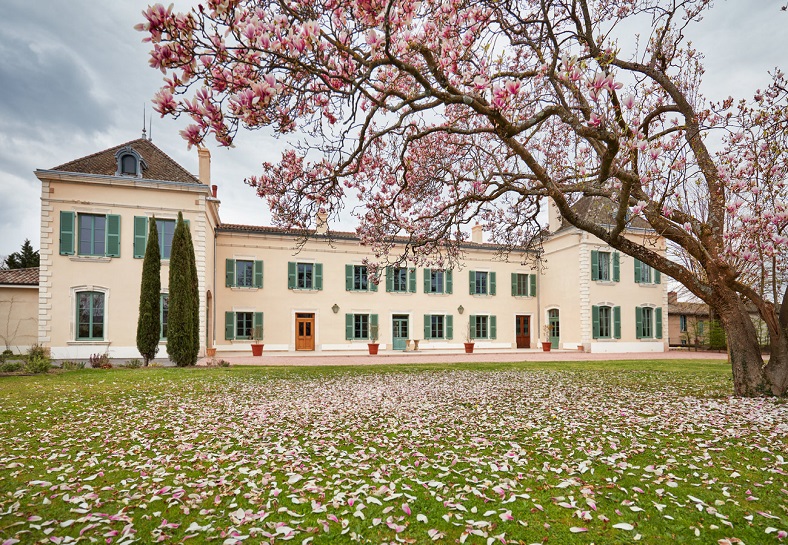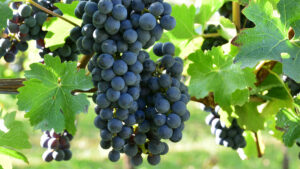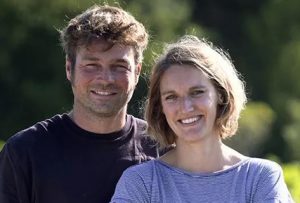
The Burgundian estate Maison Jadot came to acquire Château des Jacques over 25 years ago, in 1996, and has since made continuous efforts to increase the property’s renown, as well as the quality of its wine. Château des Jacques has since become a reference domain for Beaujolais’ viticulture. Back in 2018, iDealwine’s CEO Cyrille Jomand paid a visit to the estate for the inauguration of its new winery.
On the day of Cyrille’s visit, he got the chance to deepen his understanding of the domain and its direction thanks to the vibrant presence of talented vintner Cyril Chirouze and his predecessor Jacques Lardière. The latter is an expert in the molecular physics of wine, a rare specialism and a fascinating one.
They explained the foundational work that had been put into place by Maison Jadot over the years since they took over the property. In the vineyard, they analysed the vines parcel by parcel, before replanting some of them and altering the growing methods used. As for the vinification side of things, the Jadot team ended an era of whole-bunch harvests and semi-carbonic maceration. Instead, they (re)introduced traditional destemming, long maceration, and oak cask ageing. An almost complete overhaul, then! But they didn’t stop there…As well as renovating the château and its surrounding park land, they saw it fitting to construct an ultra-modern, top-functioning winery.
The new winery
Château des Jacques’ winery has a bit of an alternative look about it. Far from the golden barrels of a Bordeaux cellar, the interior is utilitarian and modern, with tall, silver vats framed by the roof’s exposed beams. It’s clear that what’s in front of us was built to house an ambitious and high-quality project. The harvest can be processed efficiently and comfortably, and the range of different vats include thermos-regulated steel, cement, and even ovoid containers. Such an array of equipment allows the team to precisely adapt their vinification the characteristics of different terroirs and vintages. ‘A magnificent setting,’ as summed up by Cyril Chirouze.
Horizontal tasting
A horizontal tasting of the 2016 and 2017 vintages was a wonderful way to appreciate the diversity present at Château des Jacques, including the blending work and single-parcel vinification they carry out.
To begin with we tasted the white Clos-de-Loyse, firstly in its Beaujolais blanc version matured in stainless steel vats, then in the Bourgogne blanc version, matured in 50% oak casks. Grown on the granite-rich soil of the Saône plain, in the north of Beaujolais (unlike most of the region’s whites which come from areas with golden stones), this is an original take on a Chardonnay, delicate and sapid with a honey-toned finish. The Burgundy has a nose of white peach with a generous and ample palate. Both of these are interesting in their own way.
Next up are the reds from the Moulin à Vent appellation. The domain’s Moulin à Vent is made of wines from five historic lieux-dits and three other specific ones: Vérillats, La Rochelle, and Champ de Cour. The cuvée is clean-cut with good flavour. The single-parcel Moulin à Vent cuvées are the next to be tasted. La Roche comes from a pink granite soil with a south to south-east exposure, and the result is light and airy on the palate. Le Clos du Grand Carquelin has a more clay-rich soil, facing more fully to the south, giving the wine more body, structure, and depth. Le Clos des Thorins, from deep, granite soil, is a powerful and sunny cuvée, ideal for cellaring. Our favourite, though, was Le Clos de Rochegrès, a plot grown higher up in quartz-streaked soil; it has a seductive cherry aroma on the nose, a lovely freshness, and can already be enjoyed in this vintage.
The exercise continues with wines from the Morgon appellation, and a cuvée made from the vines of three parcels: Corcelette, Côte du Puy, and Roche Noire. The differences between this wine and those from Moulin à Vent can be detected straight away. Diorite (black-blue stone) features in the earth of these parts, bringing an extra dose of power to the wine. Quite severe still at the time of tasting, it has a very full mouthfeel and a long finish. The single-parcel Cote-du-Puy is still masked by some reduction, though its density and length are more noticeable than in the domain’s general cuvée. It has a southern style, almost Rhône-like, but not too heavy.
Finally, we got to taste Château des Jacques’ Fleurie, a blend of wines from the Bel-Air and Grille-Midi parcels. Shaken up by the weather conditions in recent years, this Fleurie still manages to remain true to its identity, charming with a palate of crisp red fruits.
A visit to the vineyards
Taking a trip to the Clos du Grand Carquelin vineyard was a chance to see Burgundian growing methods at work in the Beaujolais; some of the parcels are pruned with string, allowing the grapes and their foliage to be well aerated. These parcels are cultivated alongside vines that follow more traditional methods for the region. A freshly dug pit allowed us to see into the structure of the ground underfoot; a granite-rich and mica schist soil that crumbles into sand between the fingers. Beaujolais is (like Alsace) one of the regions that showcases the greatest geological diversity, holding the key to a long-gone era when plates, volcanos, and seas shifted and fought for their place. Such a rich mix in the earth explains why you find such a varied range of wines in a relatively small region.
Château des Jacques is a real pearl of the Beaujolais, and a shining example of how regeneration, methods from other regions, and features that reflect local character can all come together to produce excellent fine wine.
You’ll find produce from Château des Jacques in stock here



